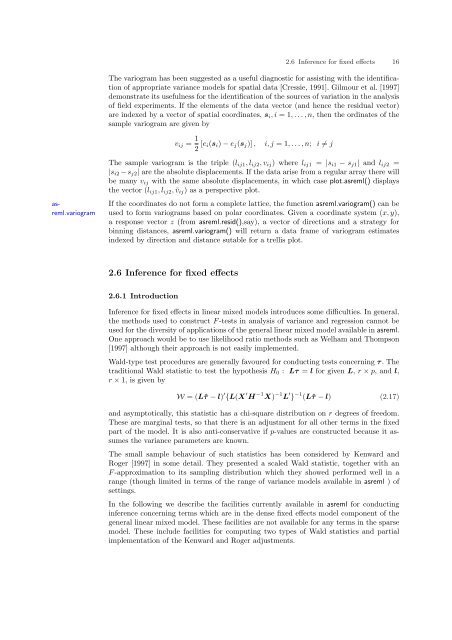ASReml-S reference manual - VSN International
ASReml-S reference manual - VSN International
ASReml-S reference manual - VSN International
- No tags were found...
Create successful ePaper yourself
Turn your PDF publications into a flip-book with our unique Google optimized e-Paper software.
2.6 Inference for fixed effects 16The variogram has been suggested as a useful diagnostic for assisting with the identificationof appropriate variance models for spatial data [Cressie, 1991]. Gilmour et al. [1997]demonstrate its usefulness for the identification of the sources of variation in the analysisof field experiments. If the elements of the data vector (and hence the residual vector)are indexed by a vector of spatial coordinates, s i , i = 1, . . . , n, then the ordinates of thesample variogram are given byv ij = 1 2 [e i(s i ) − e j (s j )] ,i, j = 1, . . . , n; i ≠ jasreml.variogramThe sample variogram is the triple (l ij1 , l ij2 , v ij ) where l ij1 = |s i1 − s j1 | and l ij2 =|s i2 − s j2 | are the absolute displacements. If the data arise from a regular array there willbe many v ij with the same absolute displacements, in which case plot.asreml() displaysthe vector (l ij1 , l ij2 , ¯v ij ) as a perspective plot.If the coordinates do not form a complete lattice, the function asreml.variogram() can beused to form variograms based on polar coordinates. Given a coordinate system (x, y),a response vector z (from asreml.resid(),say), a vector of directions and a strategy forbinning distances, asreml.variogram() will return a data frame of variogram estimatesindexed by direction and distance sutable for a trellis plot.2.6 Inference for fixed effects2.6.1 IntroductionInference for fixed effects in linear mixed models introduces some difficulties. In general,the methods used to construct F -tests in analysis of variance and regression cannot beused for the diversity of applications of the general linear mixed model available in asreml.One approach would be to use likelihood ratio methods such as Welham and Thompson[1997] although their approach is not easily implemented.Wald-type test procedures are generally favoured for conducting tests concerning τ . Thetraditional Wald statistic to test the hypothesis H 0 : Lτ = l for given L, r × p, and l,r × 1, is given byW = (Lˆτ − l) ′ {L(X ′ H −1 X) −1 L ′ } −1 (Lˆτ − l) (2.17)and asymptotically, this statistic has a chi-square distribution on r degrees of freedom.These are marginal tests, so that there is an adjustment for all other terms in the fixedpart of the model. It is also anti-conservative if p-values are constructed because it assumesthe variance parameters are known.The small sample behaviour of such statistics has been considered by Kenward andRoger [1997] in some detail. They presented a scaled Wald statistic, together with anF -approximation to its sampling distribution which they showed performed well in arange (though limited in terms of the range of variance models available in asreml ) ofsettings.In the following we describe the facilities currently available in asreml for conductinginference concerning terms which are in the dense fixed effects model component of thegeneral linear mixed model. These facilities are not available for any terms in the sparsemodel. These include facilities for computing two types of Wald statistics and partialimplementation of the Kenward and Roger adjustments.
















